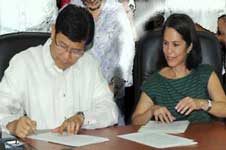DENR NAMES 6 MORE WATER QUALITY MANAGEMENT AREAS

The Department of Environment and Natural Resources (DENR) has named six more important water bodies across the country as water quality management areas (WQMAs) to better protect them from pollution.
In separate administrative orders signed by outgoing Environment Secretary Ramon J.P. Paje, the DENR designated as WQMAs the Naguilan River System in La Union; Cañas-Maalimango Rivers in Cavite; Ayala River in Zamboanga City; Taoloan River Basin in Misamis Oriental; Talomo River in Davao City and Lake Sebu in South Cotabato.
This brings to 31 the total number of WQMAs nationwide, 25 of them were designated under the Aquino administration.
“This is part of our effort to keep the country’s waterways clean and ensure the sustainable water supply for Filipinos,” Paje said.
The environment chief said the designations would help determine what control measures to institute to effectively achieve water quality objectives and improvements in those areas.
WQMAs require serious protection and management action by the local government and its stakeholders.
All six newly designated WQMAs have a combined area of 221,376 hectares of inland water systems, including land portions surrounding the water bodies.
Four of these water bodies are critical to aquifers and irrigation. These are the Naguilan River System, Talomo River, Ayala River and Lake Sebu.
Meanwhile, the designation of Cañas-Maalimango Rivers as WQMA strengthens government compliance with the Supreme Court mandamus on the cleanup of Manila Bay because the two rivers serve as major transport route of pollutants from establishments within the Cavite area.
The Tagoloan River Basin, on the other hand, serves as a repository of all water that stream through from the watershed areas of Bukidnon and Misamis Oriental provinces.
Under Republic Act No. 9275 or the Philippine Clean Air Act of 2004, the DENR, in coordination with the National Water Resources Board, to designate certain areas as WQMAs using appropriate physiographic units such as watershed, river basins, or water resources regions to effectively enforce its provisions and improve the water quality of water bodies.
The law seeks to provide a decentralized management system for water quality protection and improvement of river systems.
A total of 25 WQMAs have been designated by the DENR since President Benigno Aquino III came into power in 2010, as against the five WQMAs declared under the previous administration.
The Clean Water Act tasks the DENR to create a governing board for each WQMA, which is chaired by a regional director of the DENR’s Environmental Management Bureau (EMB). Its members include the mayor and governor of the concerned local government unit and representatives of relevant national government agencies, duly registered non-government organizations, and business and water utility sectors.
The governing board serves as a planning, monitoring and coordinating body. It also reviews the WQMA action plan prepared by the EMB.
The DENR and the stakeholders address the water quality problems, sources of pollution, and the beneficial use of the receiving water body. They also determine what control measures to institute to effectively achieve water quality objectives or improvements. ###
- Details
- Parent Category: News & Events
- Category: Press Releases



